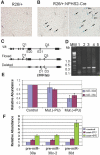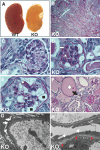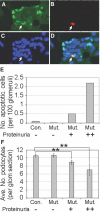Podocyte-selective deletion of dicer induces proteinuria and glomerulosclerosis
- PMID: 18776119
- PMCID: PMC2573016
- DOI: 10.1681/ASN.2008030312
Podocyte-selective deletion of dicer induces proteinuria and glomerulosclerosis
Abstract
Dicer is an enzyme that generates microRNA (miRNA), which are small, noncoding RNA that function as important regulators of gene and protein expression. For exploration of the functional roles of miRNA in glomerular biology, Dicer was inactivated selectively in mouse podocytes. Mutant mice developed proteinuria 4 to 5 weeks after birth and died several weeks later, presumably from kidney failure. Multiple abnormalities were observed in glomeruli of mutant mice, including foot process effacement, irregular and split areas of the glomerular basement membrane, podocyte apoptosis and depletion, mesangial expansion, capillary dilation, and glomerulosclerosis. Gene profiling revealed upregulation of 190 genes in glomeruli isolated from mutant mice at the onset of proteinuria compared with control littermates. Target sequences for 16 miRNA were significantly enriched in the 3'-untranslated regions of the 190 upregulated genes. Further suggesting validity of the in silico analysis, six of the eight top-candidate miRNA were identified in miRNA libraries generated from podocyte cultures; these included four members of the mir-30 miRNA family, which are known to degrade target transcripts directly. Among 15 upregulated target genes of the mir-30 miRNA, four genes known to be expressed and/or functional in podocytes were identified, including receptor for advanced glycation end product, vimentin, heat-shock protein 20, and immediate early response 3. Receptor for advanced glycation end product and immediate early response 3 are known to mediate podocyte apoptosis, whereas vimentin and heat-shock protein-20 are involved in cytoskeletal structure. Taken together, these results provide a knowledge base for ongoing investigations to validate functional roles for the mir-30 miRNA family in podocyte homeostasis and podocytopathies.
Figures




Comment in
-
Dicer cuts the kidney.J Am Soc Nephrol. 2008 Nov;19(11):2043-6. doi: 10.1681/ASN.2008090986. Epub 2008 Oct 15. J Am Soc Nephrol. 2008. PMID: 18923053 Review. No abstract available.
Similar articles
-
Podocyte-specific deletion of dicer alters cytoskeletal dynamics and causes glomerular disease.J Am Soc Nephrol. 2008 Nov;19(11):2150-8. doi: 10.1681/ASN.2008020233. Epub 2008 Sep 5. J Am Soc Nephrol. 2008. PMID: 18776121 Free PMC article.
-
Podocyte-specific loss of functional microRNAs leads to rapid glomerular and tubular injury.J Am Soc Nephrol. 2008 Nov;19(11):2069-75. doi: 10.1681/ASN.2008020162. Epub 2008 Oct 2. J Am Soc Nephrol. 2008. PMID: 18832437 Free PMC article.
-
The inducible deletion of Drosha and microRNAs in mature podocytes results in a collapsing glomerulopathy.Kidney Int. 2011 Oct;80(7):719-30. doi: 10.1038/ki.2011.122. Epub 2011 May 4. Kidney Int. 2011. PMID: 21544061 Free PMC article.
-
Detrimental effects of hypoxia on glomerular podocytes.J Physiol Biochem. 2021 May;77(2):193-203. doi: 10.1007/s13105-021-00788-y. Epub 2021 Apr 9. J Physiol Biochem. 2021. PMID: 33835424 Review.
-
Dicer cuts the kidney.J Am Soc Nephrol. 2008 Nov;19(11):2043-6. doi: 10.1681/ASN.2008090986. Epub 2008 Oct 15. J Am Soc Nephrol. 2008. PMID: 18923053 Review. No abstract available.
Cited by
-
Circulating levels of inflammation-associated miR-155 and endothelial-enriched miR-126 in patients with end-stage renal disease.Braz J Med Biol Res. 2012 Dec;45(12):1308-14. doi: 10.1590/s0100-879x2012007500165. Epub 2012 Oct 16. Braz J Med Biol Res. 2012. PMID: 23070235 Free PMC article.
-
MicroRNAs regulate renal tubule maturation through modulation of Pkd1.J Am Soc Nephrol. 2012 Dec;23(12):1941-8. doi: 10.1681/ASN.2012030321. Epub 2012 Nov 8. J Am Soc Nephrol. 2012. PMID: 23138483 Free PMC article.
-
The regulation and function of microRNAs in kidney diseases.IUBMB Life. 2013 Jul;65(7):602-14. doi: 10.1002/iub.1174. IUBMB Life. 2013. PMID: 23794512 Free PMC article. Review.
-
Evaluation of endogenous miRNA reference genes across different zebrafish strains, developmental stages and kidney disease models.Sci Rep. 2021 Nov 24;11(1):22894. doi: 10.1038/s41598-021-00075-2. Sci Rep. 2021. PMID: 34819534 Free PMC article.
-
The Role of miR-217-5p in the Puromycin Aminonucleoside-Induced Morphological Change of Podocytes.Noncoding RNA. 2022 Jun 8;8(3):43. doi: 10.3390/ncrna8030043. Noncoding RNA. 2022. PMID: 35736640 Free PMC article.
References
-
- Pillai RS, Bhattacharyya SN, Filipowicz W: Repression of protein synthesis by miRNAs: How many mechanisms? Trends Cell Biol 17: 118–126, 2007 - PubMed
-
- Borchert GM, Lanier W, Davidson BL: RNA polymerase III transcribes human microRNAs. Nat Struct Mol Biol 13: 1097–1101, 2006 - PubMed
-
- Gregory RI, Chendrimada TP, Cooch N, Shiekhattar R: Human RISC couples microRNA biogenesis and posttranscriptional gene silencing. Cell 123: 631–640, 2005 - PubMed
Publication types
MeSH terms
Substances
Grants and funding
LinkOut - more resources
Full Text Sources
Other Literature Sources

